
A tee is a stand used in sport to support and elevate a stationary ball prior to striking with a foot, club or bat. Tees are used extensively in golf, tee-ball, baseball, American football, and rugby.

A tee is a stand used in sport to support and elevate a stationary ball prior to striking with a foot, club or bat. Tees are used extensively in golf, tee-ball, baseball, American football, and rugby.
The word tee is derived from the Old Scots teaz, of unknown origin, possibly Scandinavian; apparently a plural form, or one incorrectly assumed to be so. [1] [2] [3] [4]
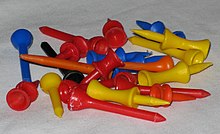

In golf, a tee is normally used for the first stroke of each hole. The area from which this first stroke is hit is in the rules [5] known as the teeing ground. Normally, teeing the ball is allowed only on the first shot of a hole, called the tee shot, and is illegal for any other shot; however, local or seasonal rules may allow or require teeing for other shots as well, e.g., under "winter rules" to protect the turf when it is unusually vulnerable. Teeing gives a considerable advantage for drive shots, so it is normally done whenever allowed. However, players may elect to play their tee shots without a tee. This typically gives the shot a lower trajectory.
A standard golf tee is 2.125" (two and one eighth inches = 5.4 cm) long, but both longer and shorter tees are permitted. Ordinary tees can be made from wood or from durable plastic. There are also many biodegradable and recyclable golf tees that diminish the number of trees cut down to manufacture the tees and allow golf courses to lower costs by not having to deal with the broken wooden tees on their courses.[ citation needed ]
According to the R&A and USGA rules of golf, for a tee to be legal, "It must not be longer than 4 inches (101.6 mm) and it must not be designed or manufactured in such a way that it could indicate the line of play or influence the movement of the ball." [6]
The development of the tee was the last major change to the rules of golf. Before this, golf balls were teed up on little heaps of sand that were provided in boxes. This explains the historical name tee boxes for what is today known as teeing ground.
The earliest golf tees rested flat on the ground and had a raised portion to prop up the ball. The first patent for this kind of tee is dated 1889, and was issued to Scotsmen William Bloxsom and Arthur Douglas. [7] The first known tee to pierce the ground was a rubber-topped peg sold commercially as the "Perfectum." This was patented in 1892 by Percy Ellis of England. [7] In 1899, an African-American dentist, Dr. George Franklin Grant, obtained a patent for an "improved golf tee". [8] This tee consisted of a wood cone with a rubber sleeve to support the ball, but it is not known to have ever been marketed.
These and other variations failed to catch on, as most golfers—whether because of tradition, habit, or concerns about the rules—continued using heaps of sand. It took a strong marketing effort by Dr. William Lowell, Sr. in the 1920s to bring manufactured tees into widespread use. Sales of his "Reddy Tee," a simple wooden peg with a flared top, took off after Lowell hired professional golfers Walter Hagen [9] and Joe Kirkwood, Sr. to promote the product during exhibition matches. It was copied around the world, and remains the most common type of golf tee.
Tee-ball is based on baseball, with the main difference being the use of a tee in the place of a pitcher. Much larger than a golf tee, the tee-ball tee is a durable rubber stand attached to the home plate which supports the baseball at a suitable height for the batter to hit. It is adjustable to allow for variations in batter height.

While a tee for baseball is very similar to a tee in tee-ball, the uses for the tee may differ. In baseball, a tee is used as a training device. This allows the hitter to simulate a pitch that will be thrown in many different locations. Using a tee, the hitter can set up a pitch that may be thrown inside, down the middle, and outside as well as high and low. Unlike tee-ball, where the ball is sitting on the tee, in baseball the pitch is being thrown by another player, resulting in the ball crossing the plate in several different areas. As a batter, using a tee as a training aid will help the hitter perfect his swing no matter where the pitch is thrown. A tee may also be used for batting drills. Drills are used to strengthen the players hitting motion and to get them used to hitting baseballs in different locations.
These tees may also be used in softball as a training device.

A kicking tee is a rubber or plastic platform, often with prongs and/or a brim around an inner depression.
In American football and Canadian football, a tee may be used on kickoffs to raise the ball slightly above the playing surface (up to one inch, by NFL and NCAA rules). The first use of the tee is attributed to Arda Bowser, a member of the Canton Bulldogs NFL championship team of 1922. The CFL and some high school leagues also allow the use of another sort of tee on field goal and extra point kicks, where another player (the holder) places one end of the ball on this "tee" (which is not a tee in the strictest sense of the term, but instead a rubber block; such "tees" come in 1" and 2" types) and holds the opposite end; in college and the NFL, all extra point/field goal attempts can only be made off the ground.
Tees may also be used for place kicks in rugby league football and rugby union football.
Tees are used for kick-outs in Gaelic football. In 2006, Shane Curran devised an adjustable tee on which the ball rested on brush hairs to replicate kicking from grass; [10] the design went on to be used by most goalkeepers. [11]
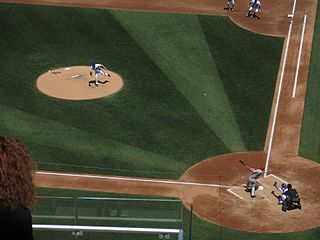
Baseball is a bat-and-ball sport played between two teams of nine players each, taking turns batting and fielding. The game occurs over the course of several plays, with each play generally beginning when a player on the fielding team, called the pitcher, throws a ball that a player on the batting team, called the batter, tries to hit with a bat. The objective of the offensive team is to hit the ball into the field of play, away from the other team's players, allowing its players to run the bases, having them advance counter-clockwise around four bases to score what are called "runs". The objective of the defensive team is to prevent batters from becoming runners, and to prevent runners' advance around the bases. A run is scored when a runner legally advances around the bases in order and touches home plate.

Rounders is a bat-and-ball game played between two teams. Rounders is a striking and fielding team game that involves hitting a small, hard, leather-cased ball with a wooden, plastic, or metal bat that has a rounded end. The players score by running around the four bases on the field.

Softball is a sport similar to baseball, and it is played with a larger ball on a smaller field and with only underhand pitches permitted. Softball is played competitively at club levels, the college level, and the professional level. The game was first created in 1887 in Chicago by George Hancock.

Tee-ball is a team sport based on a simplified form of baseball or softball. It is intended as an introduction for children to develop bat-and-ball game skills and have fun.
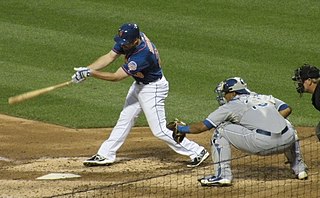
Catcher is a position in baseball and softball. When a batter takes their turn to hit, the catcher crouches behind home plate, in front of the (home) umpire, and receives the ball from the pitcher. In addition to this primary duty, the catcher is also called upon to master many other skills in order to field the position well. The role of the catcher is similar to that of the wicket-keeper in cricket.

The fastball is the most common type of pitch thrown by pitchers in baseball and softball. Its distinctive feature is its high speed. "Power pitchers," such as former American major leaguers Nolan Ryan and Roger Clemens, rely the speed of the fastball to prevent the ball from being hit and throw fastballs at speeds of 95–105 miles per hour (153–169 km/h) (officially) and up to 108.1 miles per hour (174.0 km/h) (unofficially). As an alternative to the fastball, pitchers can put movement on slower thrown balls, or throw them towards the inside or outside of home plate where batters cannot easily reach it.
Dead ball is a term in many ball sports in which the ball is deemed temporarily not playable, and no movement may be made with it. Depending on the sport, this event may be quite routine, or more uncommon.
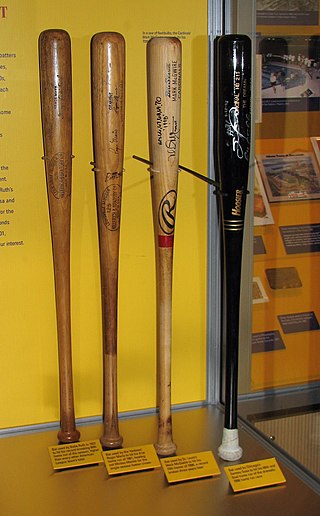
A baseball bat is a smooth wooden or metal club used in the sport of baseball to hit the ball after it is thrown by the pitcher. By regulation it may be no more than 2.75 inches (7.0 cm) in diameter at the thickest part and no more than 42 inches (1.067 m) in length. Although historically bats approaching 3 pounds (1.4 kg) were swung, today bats of 33 ounces (0.94 kg) are common, topping out at 34 to 36 ounces.

Throughout the history of baseball, the rules have frequently changed as the game continues to evolve. A few common rules most professional leagues have in common is that four balls is a base on balls, three strikes is a strikeout, and three outs end a half-inning.

A baseball field, also called a ball field or baseball diamond, is the field upon which the game of baseball is played. The term can also be used as a metonym for a baseball park. The term sandlot is sometimes used, although this usually refers to less organized venues for activities like sandlot ball.
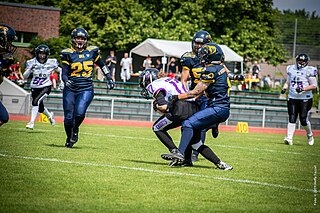
American and Canadian football are gridiron codes of football that are very similar; both have their origins partly in rugby football, but some key differences exist between the two codes.

A comparison of American football and rugby union is possible because of the games' shared origins, despite their dissimilarities.
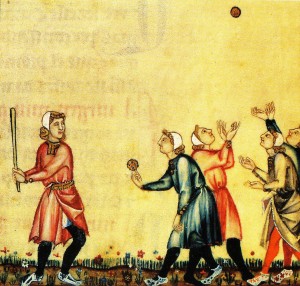
Bat-and-ball games are field games played by two opposing teams. Action starts when the defending team throws a ball at a dedicated player of the attacking team, who tries to hit it with a bat and run between various safe areas in the field to score runs (points). The defending team can use the ball in various ways against the attacking team's players to force them off the field when they are not in safe zones, and thus prevent them from further scoring. The best known modern bat-and-ball games are cricket and baseball, with common roots in the 18th-century games played in England.
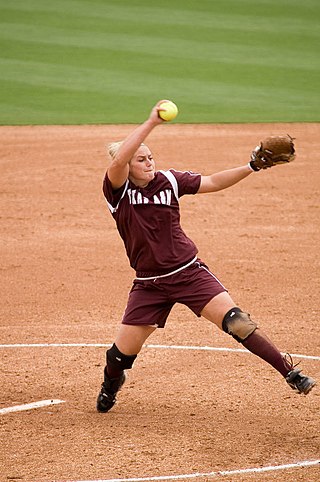
Fastpitch softball, or simply fastpitch, is a form of softball played by both women and men. While the teams are most often segregated by sex, coed fast-pitch leagues also exist. Considered the most competitive form of softball, fastpitch is the format played at the Olympic Games. Softball was on the International Olympic Committee (IOC) program in 1996, 2000, 2004, 2008, and 2020. It will not be a part of the 2024 Summer Olympic Games in Paris.
This is an alphabetical list of selected unofficial and specialized terms, phrases, and other jargon used in baseball, along with their definitions, including illustrative examples for many entries.
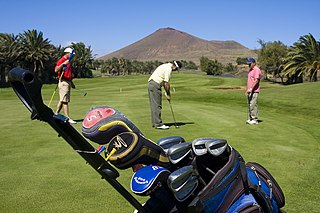
Golf equipment encompasses the various items that are used to play the sport of golf. Types of equipment include the golf ball, golf clubs, and devices that aid in the sport.
Pinners is a Chicago neighborhood game played on the front-stoop or walls with angled bricks/stones which can be used to pop the ball up in the air. References and accounts of playing exist to 1949 or earlier. The batter would throw a rubber/tennis ball at the edge of the step or angled wall brick, and the fielder(s) would try to catch the ball as it bounces back. The ball used was a two and a half-inch hollow pink soft rubber ball called a "Pinky," that bounced well off the edges of steps. Baseball gloves were not allowed. The scoring rules is similar to baseball, but with runs being virtual determined by where the ball lands. A single, double, triple or home run would be predetermined landmarks from the batting area. A catch is an out, and a one-handed catch could be used for a "rushie." As with most neighborhood games, rules varied by the groups playing and house rules would be determined at the start of the game, including the base locations. The game utilizes traditional Chicago neighborhood row house architecture, with most houses having front stairs or a stoop that leads from the front door to the sidewalk. Many of the schools built in Chicago have a horizontal perfectly angled section of decorative brick, at the right height, that was used for the game.
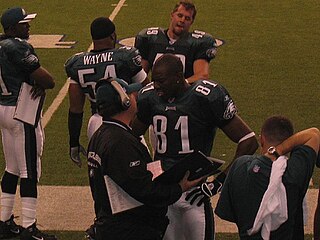
In sports, out of bounds refers to being outside the playing boundaries of the field. The legality of going out of bounds, and the ease of prevention, vary by sport. Sports that use this term include American football, Canadian football, field lacrosse, basketball, rugby union, rugby league, and association football.
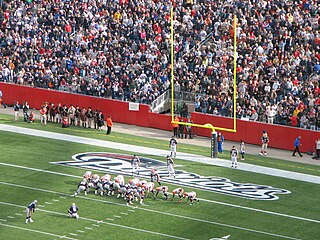
The conversion, try, also known as a point(s) after touchdown, PAT, extra point, two-point conversion, or convert is a gridiron football play that occurs immediately after a touchdown. The scoring team attempts to score one extra point by kicking the ball through the uprights in the manner of a field goal, or two points by passing or running the ball into the end zone in the manner of a touchdown.

Baseball is a bat-and-ball sport that has many recreational variants. The major sport most related to baseball is the Olympic discipline of softball, with the two sports being administered internationally alongside Baseball5 by the World Baseball Softball Confederation.
It was the former St Brigid's and Roscommon goalkeeper who devised the template for the kicking tee that most custodians now use...